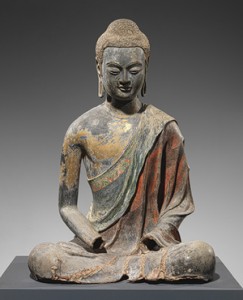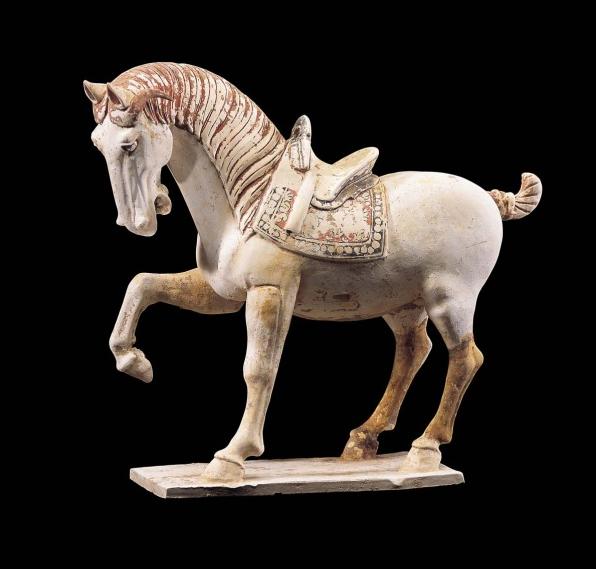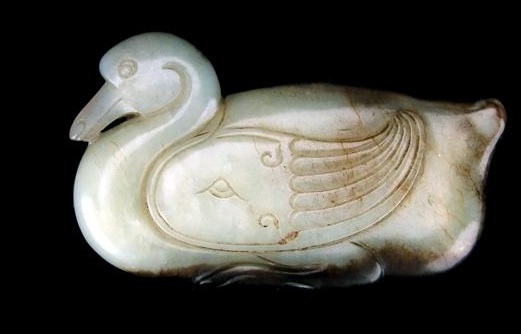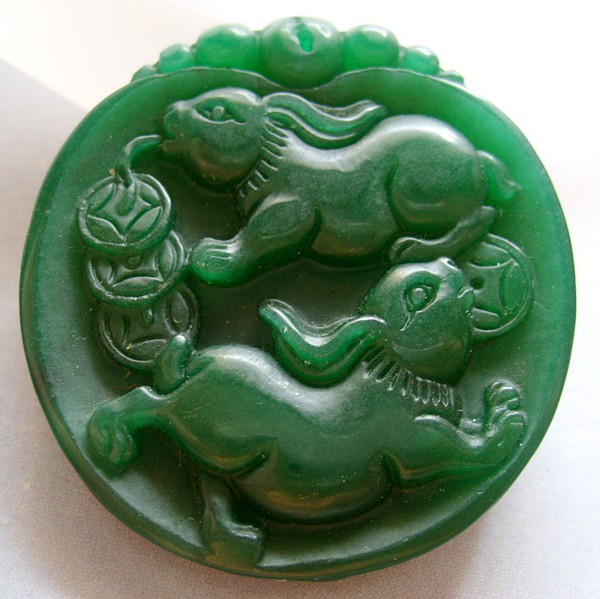The Tang Dynasty was one of the richest and most opulent periods of all Chinese history. Every aspect of art was flourishing. Painting, pottery, calligraphy, sculpture, music, dance and literature all, equally, were receiving great attention. Not only were art and artisans appreciated, so were the works of art being appreciated in every day life. Objects of art were found in the home now more than they had ever been before. Art was no longer only appreciated by the church or Royal Family, but was now appreciated by those from all walks of life. Doctors, lawyers, scholars, craftsman, businessmen and wealthy merchants all afforded themselves works of art.
 The Chinese believed that when one passes from this life to the next that it was necessary to surround one’s self with everything needed to enjoy one’s next life. The wealthier one was, the more ornate their tomb was. Our understanding of Chinese history has been greatly aided by the findings from many of these tombs. One can truly get a better feeling of what actual life was like by investigating the contents of many of these archaeological digs.
The Chinese believed that when one passes from this life to the next that it was necessary to surround one’s self with everything needed to enjoy one’s next life. The wealthier one was, the more ornate their tomb was. Our understanding of Chinese history has been greatly aided by the findings from many of these tombs. One can truly get a better feeling of what actual life was like by investigating the contents of many of these archaeological digs.
When talking about the Tang Dynasty, historians like to talk about the generations of war and the battles against the Turks. China’s land mass grew in all geographic directions and, as a result, China emerged as one of the strongest powers of all nations on the world scene. As a result of this militaristic history and conflict, we begin to see the emergence of figurines representing warriors, soldiers & their horses, guardians, officers, etc. emerging during the Tang Dynasty.
This Period experienced long periods of peace and prosperity. Vessels and utensils of all kinds were developed to a greater degree of excellence during this time. Articles of religious use were abundant during the Tang Dynasty as a result of the Buddhist influence of the Period.
The drinking of both tea and wine were commonly enjoyed past times during the Tang Dynasty. For centuries, business dealings had often been concluded by drinking a cup of tea. As the social amenities of the time grew in popularity, the evening hours found the drinking of tea and wines. There was the introduction of gorgeous tea pots and wine jars developing during this period as a result of the social customs.
This was a period of literary men and poets of great lyric. Those writing about the times wrote about great social events and evenings filled with verse and the drinking of wine. The social ambiance of the time was of extreme importance. The artists of the time contributed greatly to the development of both the social demeanour and elegance of the social events during the Tang Dynasty.
Changsha wine flasks were found at every kiln sight of the Tang Dynasty. Many historians view Changsha pottery as one of the three finest periods of manufacturing pottery in world history. Both the structure and the artistry of the Changsha pottery are of notable craftsmanship.
All of the arts prospered during the Tang Dynasty. Bronze, jade, pottery, stone carvings and more had each flourished during the Tang Dynasty.
Education, culture, religion and, needless to say, art, were extremely important to living life during the Tang Dynasty. The quality of life radiated these philosophies. The Tang Dynasty was rich with a number of the greatest craftsman who ever lived in the history of China. Because the times were abundant and people successful, we see more contributions in the field of art and history than in practically any other Dynasty.
Three-colour ware, or Sancai, was one of the greatest contributions of the Tang Dynasty. No other Dynasty before, and none since, have been so prolific in the development and production of this magnificent art form. Many Sancai figurines as well as animals (predominantly horses and camels) were produced. Sancai pieces have been found in many of the more affluent tombs of the Tang period.
Tang Sancai (or three-coloured ware) is a polychrome lead glazed decorated pottery. It doesn’t mean only three colours, but rather multi-coloured. Tang artists in China were experimenting greatly with the mixing of various shades of glaze. They seemed to share a fascination for the resulting colour from these mixtures. This three-coloured glaze technique grew out of the monochrome lead glazes used during the earlier Dynasties.










